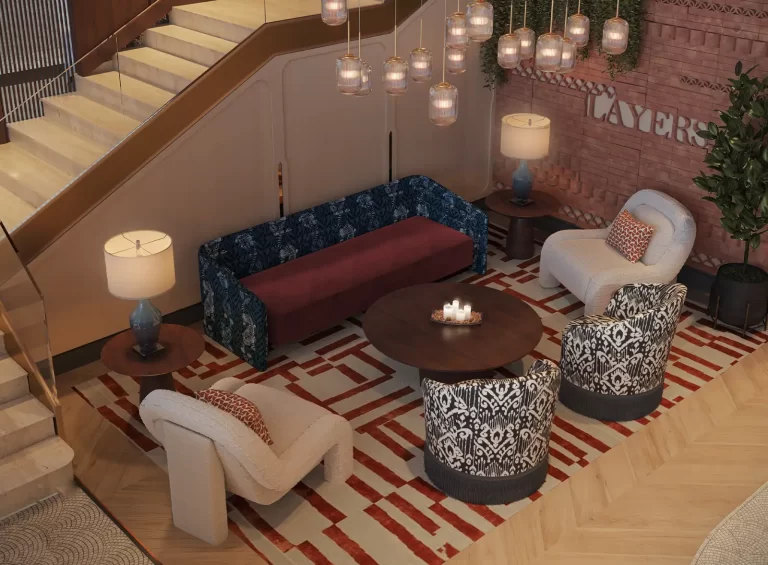
Introduction:
Prioritizing wellbeing has become an important component of modern living in Dubai, where the pace of life is as fast as the city’s skyline. One effective way to attain this equilibrium is through thoughtful home design. In this article, we look at how the junction of wellbeing and interior design may result in harmonious settings that cater to Dubai inhabitants’ distinct lifestyles.
The Impact of Interior Design on Wellbeing
Interior design influences how we perceive and interact with our surroundings, in addition to its aesthetic value. A well-designed interior can help to promote a positive and healthy lifestyle. Every facet of interior design, from creating relaxing places to optimizing practicality, contributes to a higher quality of life overall.
Elements of Wellbeing in Interior Design
- Natural Light and Open Spaces: Dubai is recognized for its abundant sunlight. Large windows and open layouts in interior design enhance natural light while also creating an airy and spacious environment. This fosters a sense of connection with the environment and improves mental health.
- Biophilic Design: Bringing nature within through the use of plants, natural materials, and organic designs is an important aspect of biophilic design. This technique is especially important in a city where the urban landscape dominates. Integrating plants into interior areas reduces stress, improves air quality, and connects people with nature.
- Balancing Modernity and Tradition: Dubai seamlessly combines modern architecture with historic influences. Wellbeing can be promoted by combining characteristics of both worlds in interior design. This balance fosters a sense of cultural identity and connectedness, which contributes to feelings of rootedness and stability.
- Comfortable and Functional Furniture: Furniture is essential to the comfort and functioning of any room. Well-designed, ergonomic furniture improves physical health by encouraging appropriate posture and reducing discomfort. In a city where people lead hectic lives, making living spaces both comfortable and useful is critical.
- Color Psychology: Color psychology explains how the colors we see might impact our mood and emotions. At Mkhalifah, we use color psychology principles to create environments that elicit various emotions. For example, calming blue and green tones are frequently utilized in bedrooms and living areas to promote relaxation and tranquillity.
- Declutter for Mental Clarity: Decluttering can improve mental clarity and reduce stress and anxiety. Interior design ideas frequently emphasize the need of decluttering in order to create an ordered and peaceful environment. Streamlining your area not only improves its visual appeal, but also encourages mental clarity and attention.

Why should we address mental health in interior design?
Mental health, defined as a condition of well-being in which people may achieve their full potential, cope with daily challenges, work efficiently, and contribute to their community, has a direct connection to physical health. The link between mental and physical well-being highlights the importance of considering mental health in interior design. Chronic stress, a common result of poorly built living environments, has been linked to a variety of physical health conditions, including cardiovascular disease, gastrointestinal difficulties, and a weakened immune system. By focusing mental health in interior design, we not only create spaces that promote emotional well-being, but also environments that help to prevent linked physical health issues.
Furthermore, research highlights the impact of our surroundings on mood and behavior, with studies demonstrating that cluttered, chaotic living spaces are associated with higher levels of sadness and anxiety than clean and orderly environments. This highlights the significant impact interior design may have on mental health outcomes, making it an important concern for general well-being.
Conclusion
The impact of design on wellness extends beyond aesthetics to include the utilization of natural light, biophilic components, and a balance of contemporary and tradition. The careful selection of furniture, consideration of color psychology, and concentration on decluttering all contribute to environments that promote overall wellbeing. Recognizing the link between mental and physical health, addressing mental health in interior design is critical due to its impact on stress levels and associated health issues. In Dubai’s hectic cosmopolitan scene, this commitment transforms places into sanctuaries of emotional balance and tranquillity. The convergence of wellbeing and interior design serves as a compass, directing the construction of places that mirror the rhythm of daily life while expressing comfort, connection, and a deep feeling of harmony.
